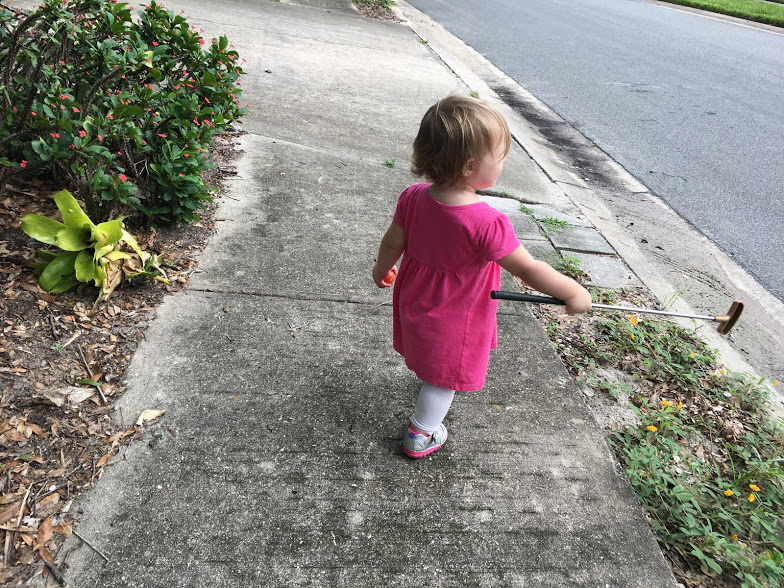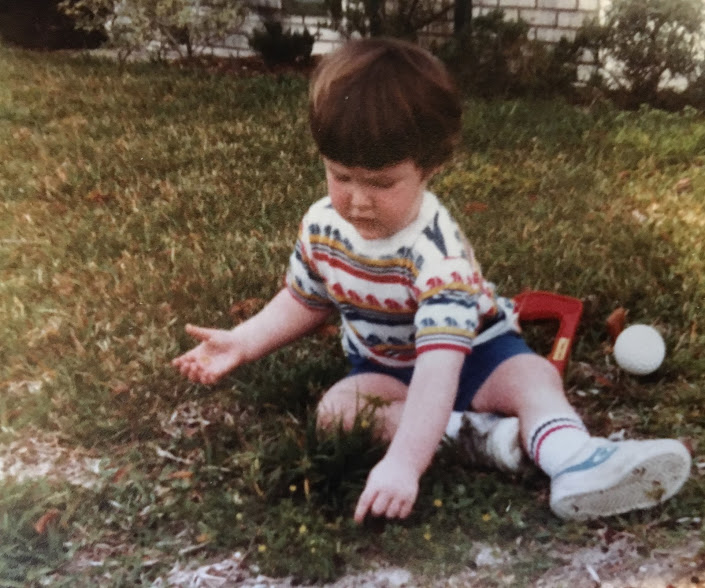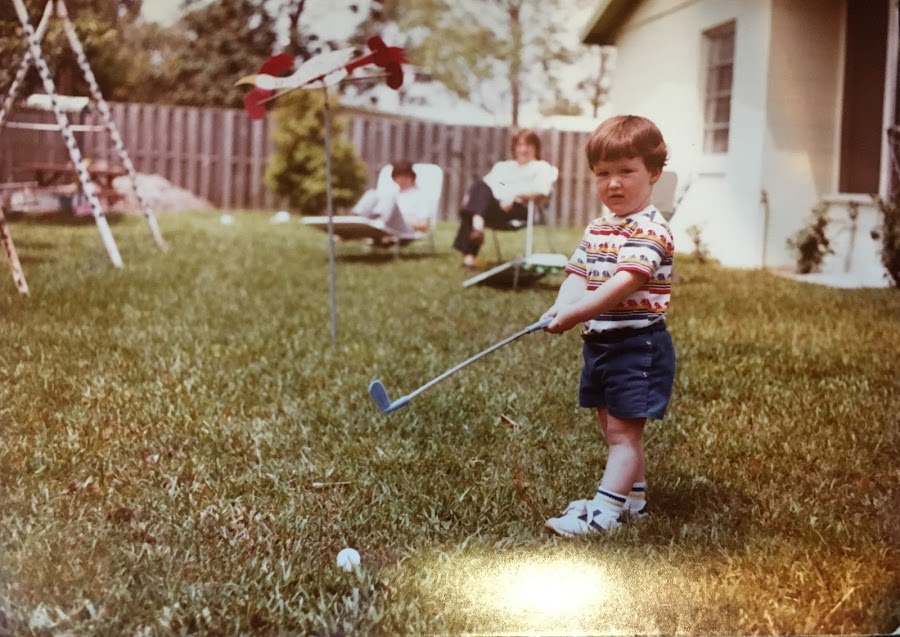Win at Yolf and Avoid Being Ridiculed by Strangers Passing By
/When I was a kid, one of my favorite activities was yolf. In case you don’t know, yolf is a contraction of yard and golf and it is golf played in one’s yard. My two best friends, brothers who lived in my neighborhood, and I invented our version of the game when we were around eleven or twelve and we continued to play it with varying levels of commitment until we were like twenty-one. We were very popular in our youth.
The set-up, rules, and game-play of yolf are simple in that they are similar to golf with a few exceptions. Here is a brief overview.
- The standard ball is a plastic wiffle golf ball.
- The preferred clubs are golf clubs that are old and/or too small. The too small part isn’t critical, but the old part is as will become clear later. If you Google yolf you will find there is some commercialized version with giant mallets, over-sized balls, and weird plastic hole things. That’s all bullshit.
- The “green” is an area of relatively flat dirt somewhere in the yard. If you have a pristine yard with consistent, beautiful carpets of grass, I’m sorry, yolf isn’t for you. We did try to grow Bermuda grass in my yard to make a more realistic putting green once, but you had to drag the hose out there to water it every morning before school and that got really inconvenient after like four days. Dirt is better anyway. You must remove all the leaves and as many small tree roots as possible when making the green and then pack the dirt down by sweeping it with a broom and stomping on it. The official cup is a plastic pot typically used for house plants that is four inches in diameter or something. This might sound like a lot of work, but yolf takes commitment.
- If the ball comes to rest within one club length of the house or in plants, bushes, or flowers that your mom cares about, you may take a free drop within two club lengths. Otherwise, the ball must be played as it lies, including off pavement. Hence the old clubs. It’s all coming together.
- Water hazards are medium-sized holes lined with black garbage bags and filled with hose water. These are optional, but are good for falling into by accident.
- Bunkers are also medium-sized holes, but without water in them. These are optional as well, but are also good for stumbling over and possibly spraining an ankle.
- The standard course consists of 9 or 18 holes depending on available space. All holes begin at different teeing areas, but conclude on the same green. Fancier courses may have two greens, one for each nine holes.
- The goal is to get the ball into the hole in as few strokes as possible. Duh.
Yolf was more than just a game to me, it was the lifeblood of my youth. Nothing could beat the feeling of hitting the links late on a Sunday evening in the summer, after the daily thunderstorms had passed, when the unbearable heat had abated, the dirt on the green was damp, compact, and perfect for scoring, and, most importantly, there were few people walking or driving around the neighborhood being nosy.
Oh, yes. There is one thing I forgot to mention about yolf. It must be played in secret. The common man does not understand yolf, so if he sees you playing it, he is likely to ridicule you mercilessly for engaging in such a childish pursuit. Or so we always assumed. We never had the courage to test our hypothesis. Our commitment to subterfuge was elaborate and nearly impenetrable.
As with any high-level cover-up, the three Cs are key: coordination, communication, and coughing. If you spot a car rounding the corner or, even worse, a pedestrian approaching, it is your duty to alert your playing partners. Protocol requires that you yell out “car” if a car is approaching. This is relatively self-explanatory. The pedestrian situation is much trickier and requires a second level of deception. This is where the coughing comes in. If a pedestrian approaches, you must cough loudly to alert other competitors.
I know what you’re thinking. What happens if someone is in the middle of their backswing when a car or pedestrian appears? The answer is easy: you alert at all costs. You never leave a brother stranded on an island of potential ridicule.
It’s these last second escapes that require the most skill and can be the most harrowing. Sometimes you might have to toss your club into the bushes (subtly, of course) or press the club against the outside of your leg and walk with a slight limp as to not seem too obvious or, if things get really desperate, dive headlong into a pile of palm fronds. Perhaps the most dangerous moments, though, happen when you are yolfing alone. Without a second pair of eyes, an old lady walking her dog can sneak up on you. There you are lining up your 2-iron tee shot from the 18th tee box, which is down by the road, when she just appears behind you out of nowhere. At this point, you are out of options. The only thing left to do is beat her over the head with your miniature club made for an 8-year-old and hide her body in one of the water hazards. Or you could take a sudden and urgent interest in a nearby ficus plant. It’s up to you.
“Would you look at these leaves,” you might say. “Does this look like a fungus to you? I brought my golf club so I could poke at it just in case.” An awkward smile and nod toward the passerby seals another successful evasion.
Yes, yolf is not a game for the faint of heart. To be great requires great discipline, patience, and a healthy dose of self-loathing. Patience is particularly important if you are playing in Florida because some of those meddlesome pedestrians are very slow moving. But, the reward is worth the effort. Some of my best days were spent on the yolf course. Shoulder to shoulder with my best friends. Not literally. That would’ve been weird. Yet we were there together in a shared space, enjoying the outdoors, not talking to each other, intently focused on the task at hand: hitting that little plastic ball into a flower pot and coughing strategically.
So, if you’re walking or driving around your neighborhood and you see some young people loitering around their yard, walking funny, admiring plants with great fascination, coughing loudly, and diving into piles of foliage, don’t worry. They’re probably just reticent yolfers living up to the yolfer’s code. Or maybe they’re doing whatever it is that kids do these days. Snapchatting and smoking pot?
Wait, did the strangers passing by think we were smoking weed? I mean, now that I think about it, all the signs were there. Wow, what a relief that is.
We were born for this
If you love this post, I have some good news. My book, Fatherhood: Dispatches From the Early Years, is available at Amazon. And if you haven’t, don’t forget to like my Facebook page.




